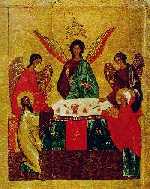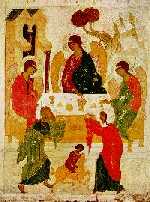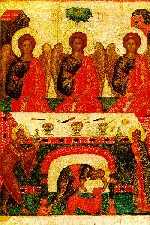++++++++++++++++++++++++++++++++++++++++++++++++++++++++++++++++++++++++++++
Andrei Rublev (ca 1360-1430) is the most famous Russian iconographer and his most famous work by far is his depiction of the Trinity. Art historian Alexander Boguslawski comments on some theological implications of this great icon.
++++++++++++++++++++++++++++++++++++++++++++++++++++++++++++++++++++++++++++
++++++++++++++++++++++++++++++++++++++++++++++++++++++++++++++++++++++++++++
Very few artists before Rublev
dared to eliminate all the narrative elements from the story, leaving
only the three angels; usually those who did so had to deal with
limited space. The results of their efforts did not find general
acceptance or many copyists. Rublev was the first to make a conscious
decision not to include in his composition the figures of Abraham and
Sarah because he did not set out to illustrate the story of the
hospitality of Abraham, as did many painters before him, but to convey
through his image the idea of the unity and indivisibility of the three
persons of the Trinity.
The doctrine of the Trinity,
difficult to explain logically, found various interpretations. Some
thought that the Trinity consisted of God the Father, God the Son, and
God the Holy Spirit. Others believed that it was just God and two
angels. In the 14th and 15th-century Russia, in the period of many
heretical movements, the idea of the Trinity was often questioned. The
heretics in Novgorod claimed that it is not permissible to paint the
Trinity on icons because Abraham did not see the Trinity but only God
and two angels. Other heretics rejected the idea of the three
hypostases of God altogether. The church fought the heresies with all
the means it had -- usually with polemical treaties, but also with
force, if necessary. Russian icon painters before Rublev subscribed to
the same point of view that Abraham was visited by God (in Christ's
image) and two angels. Hence, Christ was represented in icons of the
Trinity as the middle angel and was symbolically set apart either by a
halo with a cross, by a considerable enlargement of his figure, by
widely spread wings or by a scroll in His hand.
Trinity Icons. From left to right: Holy Trinity, a part of a quadripartite icon from Novgorod (first half of the 15th c.), Holy Trinity (Hospitality of Abraham), Novgorod School (middle of the 16th c.), Holy Trinity, Pskov School (15th c.).
In Rublev's icon for the first
time all the angels are equally important. Only this icon truly
conforms to the Orthodox idea of the Trinity. But Rublev's genius
allows the painter to go beyond the constraints of theological theme.
His icon is a special kind of challenge to the antitrinitarians --
instead of forcing them to accept the dogma, Rublev softly and gently
tries to bring them to the dogmatic understanding of the icon's meaning.
All scholars agree that the three
hypostases of the Trinity are represented in Rublev's icon. But there
are greatly differing views as to which angel represents which
hypostasis. Many see Christ in the middle angel and God the Father in
the left. Others see God the Father in the middle angel, and Christ in
the left one. The middle angel occupies a special place in the icon:
it is set apart not only by its central position, but also by a "regal"
turn of its head towards the left angel, and by pointing with its hand
towards the cup on the table. Both the turn of the head and the gesture
are important clues to the hidden meaning of the icon. Equal among
equals, the middle angel has such expressive power that one hesitates
not to see in it a symbolic representation of God the Father. On the
other hand one cannot fail to notice that the left angel is also
essential: two other angels lower their heads towards it and seem to
address it. Therefore, if we assume that the left angel is God the
Father, the middle angel, dressed in the clothes customarily used in
compositions depicting the second person of the Trinity (a blue
himation and a crimson tunic), should represent Christ. This
amazing and perhaps purposeful encoding of these two persons of the
Trinity by Rublev does not give us a clear clue for a single
interpretation. Whatever the case, the icon shows a dialogue between
two angels: The Father turns to His Son and explains the necessity of
His sacrifice, and the Son answers by agreeing with His Father's wish.
Neither of these interpretations
impacts the interpretation of the Trinity as triune God and as a
representation of the sacrament of the Eucharist. The cup on the table
is an eucharistic symbol. In the cup we see the head of the calf which
Abraham used for the feast. The church interprets this calf as a
prototype of the New Testament Lamb, and thus the cup acquires its
Eucharistic meaning. The left and the middle angels bless the cup: The
Father blesses His Son on his Deed, on His death on the cross for the
sake of man's salvation, and the Son, blessing the cup, expresses his
readiness to sacrifice Himself. The third angel does not bless the cup
and does not participate in the conversation, but is present as a
Comforter, the undying, a symbol of eternal youth and the upcoming
Resurrection.
This entry was posted
on Friday, January 29, 2016
at Friday, January 29, 2016
. You can follow any responses to this entry through the
comments feed
.
3 comments
0816jejeLes fibroblastes sont air jordan pas cher nike certainement un type de mobile qui synthétise la matrice extracellulaire asics chaussures de badminton et le collagène, le cadre structurel pour les baskets nike bebe soldes pores et les tissus de la peau ainsi nike jordan femme 7 qu'un participant essentiel dans la cicatrisation des plaies. air jordan basketball jersey Ce style attire vraiment l'attention. Mais gardez à l'esprit Asics Gel Kinsei 6 Chaussures que plus vous livrerez de personnes, basket nike flyknit femme plus vous aurez de points de vue, ce qui asics gel lyte v coral reef pas cher peut vous désorienter de ce dont vous avez réellement besoin.
August 15, 2018 at 8:30 PM
Post a Comment

Christ of Hagia Sophia
Contributors

- Joe Rawls
- I'm an Anglican layperson with a great fondness for contemplative prayer and coffeehouses. My spirituality is shaped by Benedictine monasticism, high-church Anglicanism, and the hesychast tradition of Eastern Orthodoxy. I've been married to my wife Nancy for 38 years.
Archives
Categories
- theosis
- eucharist
- Resurrection
- Benedictines
- Judaism
- Trinity
- liturgy
- Anglicanism
- Christmas
- Transfiguration
- baptism
- monasticism
- Andrewes
- Ascension
- Irenaeus
- Jesus Prayer
- Kallistos Ware
- Rowan Williams
- creed
- icons
- universalism
- Book of Common Prayer
- Climacus
- Easter
- Merton
- Rublev
- Teresa of Avila
- Underhill
- desert fathers
- incarnation
- mysticism
- repentance
- science
- Aquinas
- Athanasius
- Athos
- Cabasilas
- Clement
- Daily Office
- Gregory the Great
- Isaac of Nineveh
- Jesus seminar
- Julian
- Lossky
- Luther
- Pachomius
- Pentecost
- Ramsey
- Rule
- Wright
- angels
- christology
- ecology
- eschatology
- evangelicals
- hesychasm
- kenosis
- lectio divina
- litany
- nativity

Nicholas Ferrar
Older Posts
- "A Great Understanding"
- A Jew on the Resurrection
- A Wild and Crazy God
- Advent Repentance
- All Saints
- Amen, Brother, and Pax Vobiscum!
- Anglican Hermits in the Big Apple
- Anglican Theology: Follow the Bouncing Balls
- Anglican Values
- Anglo-Catholic Identity
- Animal Saints
- Anthony Bloom on the Transfiguration
- Ascension and the Sanctification of Matter
- Ascesis and Theosis
- Athanasius on the Trinity
- Athonite Benedictines
- Augustine on the Ascension
- Authentic Mysticism
- Baptism and Kenosis
- Bede on the Transfiguration
- Begging for Mercy in the Jesus Prayer
- Being About My Father's Busy-ness
- Benedict and the East
- Benedict on Humility in Christ
- Benedictine Stability
- Bishop Andrewes' Chapel
- Bishop Hilarion on Prayer and Silence
- Blessed John Henry Newman
- Booknote: In the Heat of the Desert
- Booknote: Short Trip to the Edge
- Booknote: The Essential Writings of Christian Mysticism
- Booknote: The Uncreated Light
- Boredom Eternal?
- Born-again Sacramentalism
- Bulgakov on the Incarnation
- Camaldoli's Eastern Roots
- Chalcedon and the Real World
- Chittister on Benedictine Prayer
- Christmas Foreshadows Easter
- Clairvaux Quotes
- Climacus Condensed
- Cloister of the Heart
- Colliander on the Jesus Prayer
- Communion After Baptism
- Communion Prayers
- Creeping Up the Ladder
- Daily Readings from the Rule of Benedict
- Darwin and the Rabbi
- Dueling Worldviews
- Ephrem the Syrian
- Esoteric and Exoteric
- Essence, Energies, Theosis
- Eucharist and Creed
- Eucharist and Ecology
- Eucharistic Quotes: Anglican
- Eucharistic Quotes: Patristic
- Eucharistic Quotes: Roman Catholic
- Evagrius on Prayer
- Exaltation of the Holy Cross
- George Herbert
- Getting Our Priorities Straight
- God in Creation
- Great O Antiphons
- Gregory of Nazianzus on Baptism
- Gregory on Michael
- Gregory the Great on Angels
- Healing Words
- Heschel on Prayer
- Hildegard on the Trinity
- Holy Fear(s)
- Incarnation and Theosis
- Irenaeus and the Atonement
- Irenaeus on Pentecost
- Irenaeus on the Trinity
- Jewish Figures in the Eastern Liturgy
- John Donne
- John of the Cross
- Julian and the Motherhood of God
- Kallistos Ware on the Jesus Prayer
- Lancelot Andrewes on the Resurrection
- Lancelot Andrewes on Theosis and Eucharist
- Latin Strikes Back
- Lectio Divina Resources
- Liber Precum Publicarum
- Litany of St Benedict
- Living in the Present Moment
- Lossky on the Transfiguration
- Luther and Theosis
- Marilyn Adams on the Resurrection
- Merton and Sophia
- Monk-animals
- Monks on Silence
- Monks, in a Nutshell
- Monstrance as Mandala
- Moralistic Therapeutic Deism
- More on Green Orthodoxy
- Myrrh-bearing Witnesses
- Mystical Tofu
- Newark's mea culpa
- Nicholas Ferrar
- No Free Passes for Skeptics
- Of Limited Pastoral Use
- Old Rites, Young Bodies
- Olivier Clement on the Eucharist
- Orthodox Thought Control
- Pachomius
- Papal Fashion Statements
- Paschal Proclamation
- Passover and Eucharist
- Patriarch's Paschal Proclamation
- Poetry by Herbert
- Polkinghorne on Creationism
- Polkinghorne on the Resurrection
- Prayers to St Benedict
- Praying With the Trinity Icon
- Priorities
- Ramsey on Anglican Theology
- RB and BCP
- Recovering Secularists
- Reinventing the Monastic Wheel
- Rescuing Darwin
- Resurrection in Judaism and Christianity
- Roman Christmas Proclamation
- Rowan on Wisdom, Science, and Faith
- Rowan Williams on Teresa of Avila
- Rowan Williams on the Resurrection
- Rublev's Circle of Love
- Rublev's Sacred Geometry
- Salvation for All Revisited
- Salvation for Everyone?
- Seraphim of Sarov
- Seven Lenten Theses
- Shell Games
- Sinai Pantocrator
- Spiritual and Religious
- St Benedict the Bridge Builder
- St Ignatius Brianchaninov on the Jesus Prayer
- St John Cassian on Prayer
- St John of Damascus
- St Joseph's Womb
- St Padraig's Creed
- Sweetman on Faith and Reason
- Symeon on the Eucharist
- Sympathy for the Devil?
- Teresa of Avila
- The Anglican Great Litany
- The Dormition of the Theotokos...
- The Green Patriarch
- The Jesus Prayer
- The Mystery of Holy Saturday
- The Resurrection is Not a Bludgeon
- Theology Isn't a Head Trip
- Theology Lite?
- Theosis and Eucharist
- Theosis and the Name of Jesus
- Theosis for Everyone
- Theosis in the Catholic Catechism
- Theosis: What it's all about
- Thomas Merton on the Jesus Prayer
- Three Faces of CS Lewis
- Transfiguration and Suffering
- Transfiguration Quotes
- Trinitarian Dance
- Two Sides of the Same Coin
- Underhill on Theosis
- Underhill on Worship
- Victory in Christ
- Virgin of the Sign
- What's Really Important?
- Why the Creed Matters
- Wright on the Resurrection
- Young Geezers and the Liturgy
- Zizioulas on Baptism and Eucharist

Lancelot Andrewes
Anglicans
- A Desert Father
- A Red State Mystic
- Affirming Catholicism
- All Things Necessary
- Anglican Communion
- Anglican Eucharistic Theology
- Anglican Society for the Welfare of Animals
- Anglo-Orthodoxy
- Catholicity and Covenant
- Celtic-Orthodox Connections
- Chantblog
- Chicago Consultation
- Creedal Christian
- Don't Shoot the Prophet
- Episcopal Cafe
- Episcopal News Service
- Evelyn Underhill
- Faith in the 21st Century
- For All the Saints
- In a Godward Direction
- Inclusive Orthodoxy
- Interrupting the Silence
- Into the Expectation
- N. T. Wright
- Nicholas Ferrar and Little Gidding
- Preces Privatae
- Project Canterbury
- Society for Eastern Rite Anglicanism
- Society of Catholic Priests
- St Bede's Breviary
- Taize Community
- The Anglo-Catholic Vision
- The Benedictine Spirit in Anglicanism
- The Conciliar Anglican
- The Daily Office
- The Hackney Hub
- The Jesus Prayer (Anglican perspectives)
- The St Bede Blog
- Thinking Anglicans

St Benedict Giving the Rule

St Gregory Palamas
Eastern Christians
- A Spoken Silence
- A Vow of Conversation
- Ancient Christian Defense
- Ancient Faith Radio
- Antiochian Orthodox Church
- Coptic Church
- East Meets East
- Eclectic Orthodoxy
- Ecumenical Patriarchate
- Glory to God for All Things
- Hesychasm
- Jewish Roots of Eastern Christian Mysticism
- Malankara Syriac Church
- Mar Thoma Syrian Church of Malabar
- Monachos
- Mount Athos
- Mystagogy
- Nestorian Church
- Occidentalis
- Orthodox Arts Journal
- Orthodox Links
- Orthodox Peace Fellowship
- Orthodox Way of Life
- Orthodox Western Rite
- OrthodoxWiki
- Pravoslavie
- Public Orthodoxy
- Salt of the Earth
- The Jesus Prayer

St Gregory the Great



